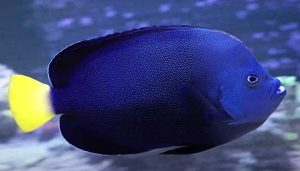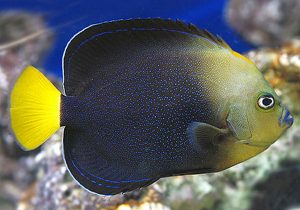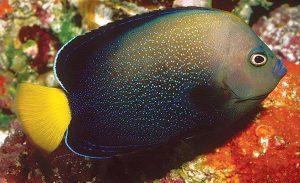Bluespotted Angelfish (Chaetodontoplus caeruleopunctatus) known to tropical fish keeping enthusiasts as the Blue Spangled Angelfish or Yellowtail Poma Angel is a seldom encountered species endemic to the Phillipine Archipelago.
Bluespotted Angelfish are found along the deeper rocky areas of reefs around rich growths of sponges and algae at depths between 40 to 140 feet. Although they are occasionally seen alone feeding on sponges and tunicates, they are seldom seem in pairs or smaller groups.
The Bluespotted Angelfish is colored an orange brown on the face, head, and anterior portions of the body, with the remainder colored a dark dusky brown to bluish black. Dense small blue spots cover the entire body except for the face. The dorsal and anal fins are dark brown to black with blue margins and the caudal fin is a stunning, bright yellow color. Males and females cannot be differentiated by size or color and like other marine angelfish, Chaetodontoplus caeruleopunctatus are protogynous hermaphrodites, with all individuals initially starting life as females until the dominant female in a group change into a male.
Juveniles have a dark brown to almost black body color with yellow stripes on the anterior portion of the back, on the head, and around the dorsal fin. The caudal fin on juvenile specimens is colored yellow and white.
Bluespotted Angelfish do best in a mature. well established fish only (FOLR) aquarium of at least 125 gallons with plenty of live rock arranged into caves, overhangs, and crevices for them to graze and hide among. Bluespotted Angelfish are relatively non-aggressive and should be kept with other peaceful tankmates. Aquarium tank mates with calm demeanors include tangs, clownfish, damsels, gobies, blennies, butterflies and other similar species.
To avoid territorial conflicts, other angelfish should not be housed with Chaetodontoplus caeruleopunctatus unless the tank is a large one with plenty of live rock.
Bluespotted Angelfish are not considered reef safe and will nip at stony corals, soft corals, and Tridacnid Clam mantles. They do eat filamentous algae with gusto.
Although Bluespotted Angelfish have been successfully bred commercially, no reports of successful breeding in an aquarium environment have been reported.
Like other marine angelfish, Chaetodontoplus caeruleopunctatus lay pelagic eggs and have pelagic larvae. Their spawning ritual occurs during the evening or at night where a spiraling dance is performed until the eggs and sperm are released into the water column. After spawning, the eggs are left to float in the water column.
In the wild, the diet of the Bluespotted Angelfish is primarily composed of sponges, diatoms, and tunicates. In an aquarium environment, they will graze and pick on the live rock, filamentous algae, sponges, diatoms, etc. and should be provided fresh, frozen, or freeze dried Spirulina
, marine algae
, Mysis or frozen shrimp, and other meaty items along with a high quality angelfish preparation at least three times a day.
Although Bluespotted Angelfish (Chaetodontoplus caeruleopunctatus) are rarely exported to the aquarium trade, tropical fish keeping enthusiasts can occasionally obtain them online from a few specialty transhippers at these approximate purchase sizes: Small: 2″ to 3″; Medium: 3-1/2″ to 5″; Large: 5″ to 7″. Costs for Indo Pacific specimens vary from $89.99 to $195.00 depending on size.
CAUTION: Although shipments from Cebu are relatively frequent, specimens usually die at some point in holding tanks, probably due to the collectors use of cyanide.
Minimum Tank Size: 125 gal
Aquarium Type: FOLR
Care Level: Difficult
Temperament: Semi Aggressive
Aquarium Hardiness: Hardy when acclimated
Water Conditions: pH 8.1-8.4, 72° to 82°F, dKH 8 – 12°, SG 1.021-1.025
Max. Size: 8″
Color Form: Yellow, Blue, Brown
Diet: Omnivore
Compatibility: Peaceful Community
Origin: Indo-Pacific Ocean
Family: Pomacanthidae
Lifespan: 10-15 years
Aquarist Experience Level: Advanced




